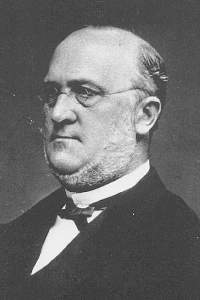- Adolph Wilhelm Hermann Kolbe
Infobox_Scientist
name = Adolph Wilhelm Hermann Kolbe
caption = Adolph Wilhelm Hermann Kolbe
birth_date = birth date|1818|9|27|mf=y
birth_place = Elliehausen nearGöttingen ,Germany
residence =Germany ,England
nationality = German
death_date = death date and age|1884|11|27|1818|9|27|mf=y
death_place =Leipzig ,Germany
field =Chemist
work_institutions =University of Marburg University of Leipzig
alma_mater =University of Marburg
doctoral_advisor =Robert Bunsen
Friedrich Wöhler
doctoral_students =Peter Griess
Aleksandr Mikhailovich Zaitsev
Theodor Curtius
Ernst Otto Beckmann
Carl Graebe
Oscar Loew
Constantin Fahlberg
Nikolai Menshutkin
Vladimir Markovnikov
Jacob Volhard
Ludwig Mond
Alexander Crum Brown
Maxwell Simpson
Frederick Guthrie
known_for =Kolbe electrolysis ,
Kolbe-Schmitt reaction
Kolbe nitrile synthesis
prizes =
religion =
footnotes =Adolph Wilhelm Hermann Kolbe (
September 27 ,1818 –November 25 ,1884 ) was a Germanchemist . He never used the first two of his given names, preferring to be known simply as Hermann Kolbe.Life
Kolbe was born in Elliehausen, near
Göttingen ,Kingdom of Hanover (Germany ) as the eldest son of a Protestant pastor. At the age of 13 he entered the Göttingen Gymnasium, residing at the home of one of the professors. He obtained the leaving certificate (theAbitur ) six years later. He had become passionate about the study of chemistry, matriculating at theUniversity of Göttingen in the spring of 1838 in order to study with the famous chemistFriedrich Wöhler .In 1842 he became an assistant to
Robert Bunsen at theUniversity of Marburg ; he took his doctoral degree there in 1843. A new opportunity arose in 1845, when he became assistant to Lyon Playfair at the newMuseum of Economic Geology in London, where he became a close friend ofEdward Frankland . From 1847 he was engaged in editing the "Handwörterbuch der reinen und angewandten Chemie" ("Dictionary of Pure and Applied Chemistry") edited byJustus von Liebig , Wöhler, andJohann Christian Poggendorff , and he also wrote an important textbook. In 1851 Kolbe succeeded Bunsen as professor of chemistry at Marburg, and in 1865 he was called to the University ofLeipzig .In 1853 he married Charlotte, the daughter of General-Major Wilhelm von Bardeleben. His wife died in 1876 after 23 years of happy marriage. They had four children.
Work
As late as the 1840s, and despite Friedrich Wöhler's synthesis of urea in 1828, some chemists still believed in the doctrine of
vitalism , according to which a special life-force was necessary to create organic compounds. Kolbe developed the idea thatorganic compound s could be derived from inorganic ones, directly or indirectly, by substitution processes. He validated his theory by convertingcarbon disulfide , in several steps, toacetic acid (1843-45). Introducing a modified idea of structural radicals, he contributed to the establishment ofstructural theory . One of the more dramatic successes of his theory was his prediction of the existence of secondary and tertiaryalcohol s, a conjecture that was soon confirmed by the synthesis of these substances.He worked on the
electrolysis of the salts of fatty and otheracid s (Kolbe electrolysis ) [cite journal
title = Untersuchungen über die Elektrolyse organischer Verbindungen
author = Hermann Kolbe
journal =Annalen der Chemie und Pharmacie
year = 1849
volume = 69
issue = 3
pages = 257–372
doi = 10.1002/jlac.18490690302] and preparedsalicylic acid , a building block ofaspirin in a process calledKolbe synthesis orKolbe-Schmitt reaction [cite journal
title = Ueber Synthese der Salicylsäure
author = Hermann Kolbe
journal =Annalen der Chemie und Pharmacie
year = 1860
volume = 113
issue = 1
pages = 125–127
doi = 10.1002/jlac.18601130120] . A certain method for the synthesis of nitriles is called theKolbe nitrile synthesis .Hermann Kolbe was the first person to use the word synthesis in the present day meaning.
With
Edward Frankland he found thatnitrile s can be hydrolyzed to the corresponding acids.Conflicts
As editor of the "Journal für praktische Chemie" ("Journal of practical chemistry", from 1870 to 1884), Kolbe was sometimes so severely critical of the work of others, especially after about 1874, that some wondered whether he might have been suffering a mental illness. He was intolerant of what he regarded as loose speculation parading as theory, and sought through his writings to save his beloved science of chemistry from what he regarded as the scourge of modern structural theory.
His rejection of structural chemistry, especially the theories of the structure of benzene by
August Kekulé , the theory of the asymmetric carbon atom by J.H. van't Hoff, and the reform of chemical nomenclature byAdolf von Baeyer , resulted in vituperative articles in the "Journal für Praktische Chemie". Some translated quotes illustrate his manner of articulating the deep conflict between his interpretation of chemistry and that of the structural chemists: "...Baeyer is an excellent experimentor, but he is only an empiricist, lacking sense and capability, and his interpretations of his experiments show particular deficiency in his familiarity with the principles of true science..." [cite journal
title = Begründung meiner Urtheile über Ad. Baeyer's wissenschaftliche Qualification
author = Hermann Kolbe
journal = Journal für Praktische Chemie
volume = 26
issue = 1
year = 1882
pages = 308–323
doi = 10.1002/prac.18820260121 ]The violence of his language worked unfairly to limit his posthumous reputation. He died of a heart attack, in
Leipzig .References
Further reading
*
*
Wikimedia Foundation. 2010.
